13th Annual School of Art and Design Graduate Exhibition
Twenty-one graduate students in the ECU School of Art and Design Master of Fine Arts program presented their work in this virtual exhibit. Trista Reis Porter, executive director of the Greenville Museum of Art, served as this year’s juror. Diverse works include prints, drawings, textile, metal designs, sculpture, photography, ceramics and more.
Award Winners
Friends of Joyner Library Purchase Award: Madison Johnson, Point of Hunt Series
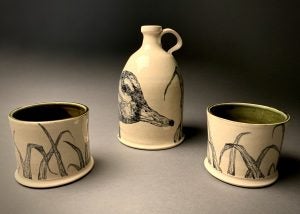
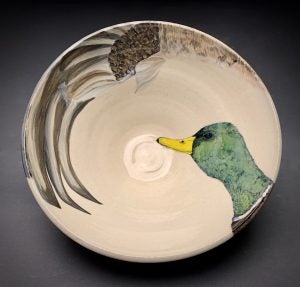
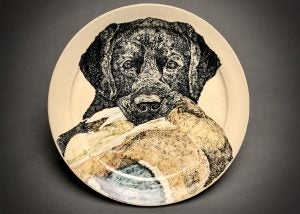
Born and raised in a small, rural town in North Carolina, hunting is a cultural pillar in my community. Opening day of hunting season is met with the same notoriety of a National Holiday. Hunting is how my family and many others have been able to keep food on the table and provide for themselves. Hunting is a sport to some in the area but essential to many more. Many of my inspirations for my work come from the various experiences that come from a hunt. The idea that one thing can supply food for a family, while simultaneously bringing joy, humility, and lasting memories to those participating. Harvesting one’s own food can maximize quality, freshness, and nutrition.
Wildlife hunting has been important since the very beginning of time. Hunting is a wildlife management tool. It keeps nature at a healthy balance of which the available habitat can support. Hunting also helps to maintain populations at levels compatible with human activity and land use.
Waterfowl hunters are an important source of revenue for state and federal conservation programs. The support from duck hunters has been the foundation of wetlands conservations ever since the Federal Duck Stamp was issued in 1934. Waterfowl hunters conserve land and keep toll of the population, and make sure that the ducks are well nourished year around. Hunters are not solely focused on the harvest but to preserve the populations and conservation efforts needed to ensure future generations will have the same opportunities to make lasting memories with friends and family.
The idea of functional work is important to me. I make artwork that can be viewed as a painting, but you can also enjoy your morning coffee or afternoon dinner with my pieces. I use white clay mixed locally in Buncombe County, North Carolina, a neighboring town to where I am from. I paint images of waterfowl that migrate through North Carolina on my ware with underglazes. The waterfowl that I paint are Mallards, Black Duck, American Wigeon, Northern Pintail, Canada Goose, and the Wood Duck. I want viewers to understand the importance of hunting. Hunters have been conserving wetlands for more than one hundred years. They have made a huge positive impact on our world. My work is bringing a light to the values of hunt to table, knowing where your meat comes from, and the importance of local, sustainable, and ecologically conscious meat, to remind people why hunting is so important to our world.
–Madi Johnson
College of Fine Arts and Communications Dean’s Merit Award: Karena “Kidd” Graves, Squeezed
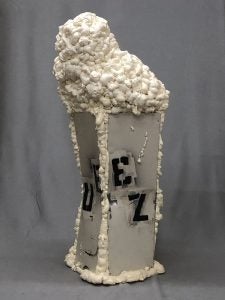
Karena “Kidd” Graves ‘ work is an exploration and manipulation of found junk metals and materials. They find items that have a lot of movement or organic feel to them, bring them back to the studio and assemble them into sculptures.
The artworks in this show are conversations of duality, action, and nature. Can one material that is hard look just as soft as another and vice versa? Can an action be made and expressed in not only movement but in words? Can junk reflect the organic movement of water? Their work is not an answer to these questions but an exploration of how thrown away items can be brought back to life and manipulated into further meaning.
School of Art and Design Director’s Award: Katya Hutchinson, Pitcher
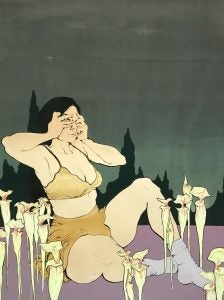
Amidst a hostile world with un-forgiving realities, it seems natural to wish for something different. During isolation, I found myself delving back into daydreaming -searching for the fantastical safe spaces I’d created in childhood. These pieces reflect that search, and the ultimate realization that no form of escapism is safe from the infiltration of reality.
Katya Hutchinson
School of Art and Design Award: Peter Borsay, Vaxius
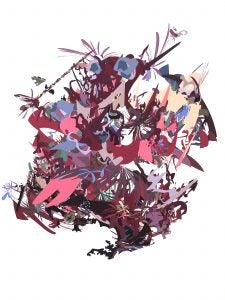
I’m a printmaker who creates dynamic, vibrant, semi-representational/abstract artwork. The prints express a subconscious fusion of made-up forms and figures that exploit the pictorial space. This extensive body of work is influenced by graphic pen-and-ink drawings and abstract prints. I use a variety of methods that combine traditional drawing and printmaking with digital/hybrid printmaking to create compositions. Mixing printmaking techniques, experimenting with different mediums and playing with design or architectural motifs are all part of my studio practice.
Pete Borsay
Dowdy Student Store Award: Julienne Beblo, Nathan’s Bowl
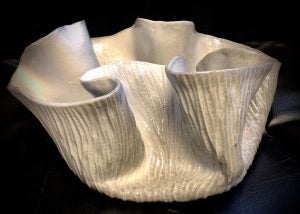
Ceramics is the ultimate combination of science and creativity. I relish juxtaposing the precision and interactions found in science with the organic forms and uncertainty associated with ceramics. The natural world, particularly within the ocean, is multidimensional and dynamic. Ceramics lends itself to the replication and portrayal of marine environments, organisms, and interactions.
Art cannot exist without science, nor science without art. By going beyond simply understanding the science behind art, I hope to use art to, in return, captivate the attention of others regarding environmental issues. It bothers me when there is a problem and an existing solution and yet it is not being done. My interest in marine conservation and ceramics provides an interdisciplinary approach to communicating science, addressing these environmental issues, and highlighting applicable and feasible solutions.
Julienne Belbo
The exhibit and the purchase award are sponsored by the Friends of the Library at East Carolina University.
